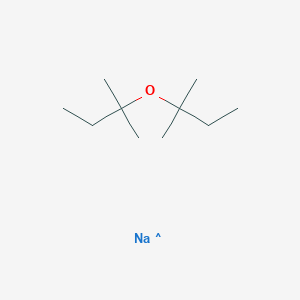
Sodium t-amyl oxide
- 点击 快速询问 获取最新报价。
- 提供有竞争力价格的高质量产品,您可以更专注于研究。
描述
Sodium t-amyl oxide is a useful research compound. Its molecular formula is C10H22NaO and its molecular weight is 181.27 g/mol. The purity is usually 95%.
BenchChem offers high-quality this compound suitable for many research applications. Different packaging options are available to accommodate customers' requirements. Please inquire for more information about this compound including the price, delivery time, and more detailed information at [email protected].
科学研究应用
Organic Synthesis
Sodium t-amyl oxide serves as a strong base in organic reactions, facilitating the deprotonation of weak acids. This property is essential for forming carbon-carbon bonds, which are crucial in synthesizing complex organic molecules. Its role in organic synthesis can be summarized as follows:
Polymer Chemistry
In polymer chemistry, this compound is utilized to synthesize polyolefins, which are essential for producing plastics and elastomers with enhanced properties. Its applications include:
| Application | Description |
|---|---|
| Polymerization | Facilitates the polymerization process to create high-performance materials. |
| Material Properties | Enhances the mechanical and thermal properties of polymers . |
Pharmaceutical Development
This compound plays a critical role in pharmaceutical development by acting as a reagent in the synthesis of drug intermediates. Its applications include:
Analytical Chemistry
In analytical chemistry, this compound enhances the sensitivity and selectivity of assays, making it valuable for quality control processes. Its contributions include:
| Application | Description |
|---|---|
| Assay Enhancement | Improves detection limits and specificity in chemical analyses. |
| Quality Control | Used in various assays to ensure compliance with regulatory standards . |
Environmental Applications
This compound has potential applications in environmental remediation, particularly in breaking down hazardous substances through chemical reactions. Its role includes:
| Application | Description |
|---|---|
| Contaminant Remediation | Utilized to degrade pollutants in contaminated sites through chemical reactions . |
Case Study 1: Organic Synthesis
A study demonstrated the use of this compound in synthesizing complex molecules such as alkaloids and terpenes through deprotonation reactions that facilitated carbon-carbon bond formation.
Case Study 2: Pharmaceutical Development
Research highlighted this compound's effectiveness in synthesizing pharmaceutical intermediates for anti-inflammatory drugs, showcasing its importance in drug discovery and development processes.
Case Study 3: Environmental Remediation
An investigation into the use of this compound for remediating soil contaminated with heavy metals showed promising results, indicating its potential for breaking down toxic substances effectively.
属性
分子式 |
C10H22NaO |
|---|---|
分子量 |
181.27 g/mol |
InChI |
InChI=1S/C10H22O.Na/c1-7-9(3,4)11-10(5,6)8-2;/h7-8H2,1-6H3; |
InChI 键 |
UIIJZQVROQHLAP-UHFFFAOYSA-N |
规范 SMILES |
CCC(C)(C)OC(C)(C)CC.[Na] |
产品来源 |
United States |
Synthesis routes and methods I
Procedure details




Synthesis routes and methods II
Procedure details





体外研究产品的免责声明和信息
请注意,BenchChem 上展示的所有文章和产品信息仅供信息参考。 BenchChem 上可购买的产品专为体外研究设计,这些研究在生物体外进行。体外研究,源自拉丁语 "in glass",涉及在受控实验室环境中使用细胞或组织进行的实验。重要的是要注意,这些产品没有被归类为药物或药品,他们没有得到 FDA 的批准,用于预防、治疗或治愈任何医疗状况、疾病或疾病。我们必须强调,将这些产品以任何形式引入人类或动物的身体都是法律严格禁止的。遵守这些指南对确保研究和实验的法律和道德标准的符合性至关重要。













